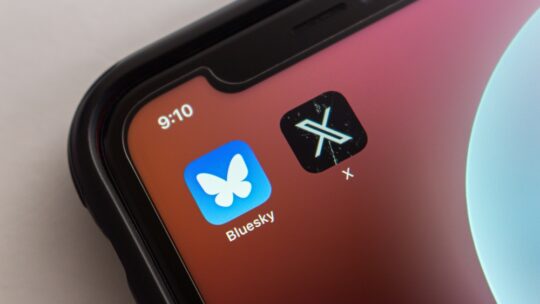
Social media trends come and go, but it has been a while since an existing social media platform (Bluesky) has encouraged so many users to jump ship and abandon their current social media habits. Such moves warrant the attention of the PR and communication industry.
The Bluesky Glow Up
According to TechCrunch, Bluesky, a social media app ideated by former Twitter CEO Jack Dorsey, topped 20 million users as of Nov. 19, 2024. The exodus of users trickling from X (formerly Twitter) started in 2022 when Elon Musk purchased the company and has continued steadily amid Musk’s partisan political posts, controversial update to blocking features, among other things.
Bluesky started in Feb. 2023 by invitation-only, but it opened its doors to the public in Feb. 2024. The trickle of users became a flood quickly after the 2024 U.S. presidential election, with the service adding over one million in just one week.
As of Nov. 20, 2024, it’s listed as the top free and social networking app on the App Store for iPhone and the top free app for Google Play. Threads follows Bluesky at second in both categories.
In a recent interview with CNN, Bluesky CEO Jay Graber noted that the platform’s focus has been to create trust and openness for the consumer.
“Our goal is to give users an experience where they can have fun and feel safe,” she said.
The PR Industry Impact
Perhaps due to its safety protocols and improved moderation, many public figures, journalists, celebrities and organizations have been announcing their move to Bluesky and, for some, the deactivation of their X accounts. Actor Mark Hamill, the NFL’s Philadelphia Eagles, Rep. Alexandria Ocasio-Cortez and musician Lizzo are just a few of those making their presence known on the app.
So what does this mean for the PR industry? What will change for those practitioners who utilized X to build media relationships and get to know reporters?
PRNEWS took an informal poll asking readers if they were sticking with the X. The results are a combination of two polls conducted of 166 voters, one on PRNEWS’ LinkedIn page and another on PRNEWS Managing Editor Nicole Schuman’s LinkedIn page.
The question posed:
Is your brand moving away from X (Twitter)?
Answers (rounded to nearest percentage point):
- Yes. Deactivated. Done. 37%
- No, still using daily. 24%
- Yes, and moved to Bluesky or Threads. 18%
- Yes, but still using all the platforms (including X). 21%
The results showed a divide between communicators over who is and who isn’t using X. A total of 54.8% have left the platform and/or are using Bluesky or Threads. And 45% have not yet abandoned X and are utilizing many social media platforms in their toolbox.
User Perspectives
PR pros’ interpretations of the rise in popularity of Bluesky were split as well. While some are ready to explore new avenues and audiences, others aren’t so quick to believe the hype.
Sarah Bertness Glawe, VP of Digital Strategy at Powell Communications and a self-professed “social media strategist since MySpace,” has noticed some B2B and consumer brands moving over to the Threads platform quite successfully, and the engagement metrics have been encouraging to her. She sees Bluesky attracting political and progressive voices, as well as media.
“Journalists have been looking for a home for live news discourse to replace X (Twitter) and the Threads algorithm paired with the de-prioritization of political content and news has left a big gap that Bluesky is now positioned to fill,” Bertness Glawe says. “TBD on how they manage the influx and meet the need with their algorithm. To be the new “town square,” it will need to be just right.”
Kenneth Ziegler, an expert in AI ethics compliance and customer success, sees the current exodus away from X as a realization that X has become a “more established Truth Social,” and believes X now reflects on companies’ reputations as a whole.
“Only certain brands would want to be promoted or seen alongside the content that is being monetized on X,” Ziegler says.
He goes on to note that while Musk fights this designation, he’ll eventually realize he’s made that “town square” a place where “open violence happens more than free speech,” and that organizations cannot hitch their wagon (and dollars) to it.
“Why would a brand stay when it’s easier to put your resources into other media that have better moderation to maintain a healthier audience?” he asks.
However, not everyone agrees that Bluesky will be the death blow to X. Brian Hart, Founder and President of Flackable, says the storyline is not new and remains skeptical.
“We saw it play out when Donald Trump tried to rail against X/Twitter with his Truth Social rollout,” Hart says. “Mark Zuckerberg took a shot at capturing disaffected X users by launching Threads 18 months ago. And we’ve seen countless other competing platforms flame out over that time. In that context, I have zero confidence Bluesky will become a viable competitor.”
Erin Monday, Growth Marketing Director at IBM, believes X is actually gaining in popularity/users, as it is listed as the top “News App” currently in the App Store for iPhone. She says she’ll be exploring it as an advertising platform.
“Prior to Musk’s acquisition, the paid advertising on Twitter was handily the worst out of the big platforms and was a 100% DNU,” she says. “Excited to see what changes have been made that may help with conversion.”
She also notes that the media should not ignore the power X still holds. “Legacy media will continue to make X a bogeyman when it is, in fact, the future—and their downfall.”
Think Before You Leap
For some time, brands and organizations have lived and died by their use of social media platforms. Many companies have relied on them for customer service issues (see the airline industry). While X, Facebook Messenger and Instagram Messages are still used for this purpose, organizations are looking elsewhere to fulfill that need.
Kate Wolcott Rizzo, Director, Marketing and Creative at Ashley Furniture, says all customer service inquiries for their organization have moved to text messaging, and all social media messages are redirected to a text conversation.
“We did research in our customer base and found an overwhelming majority of people want to text about service-related issues,” Wolcott Rizzo says.
She notes that the company is using an AI agent during overnight hours, holidays and exceptionally busy times for common, basic answers, but that human agents always handle issues when someone is available or if it becomes complex.
Monday says companies should not throw all their eggs into one social media basket, because most CSR tools used to manage social media monitoring and follow up can take years to add functionality for new social media platforms.
“Maybe this will accelerate with AI but… brands should stay where the majority of their customers or prospects are if they want to gather competitive intelligence, do market research or engage,” she says.
Nicole Schuman is Managing Editor at PRNEWS.






